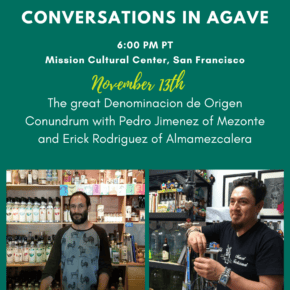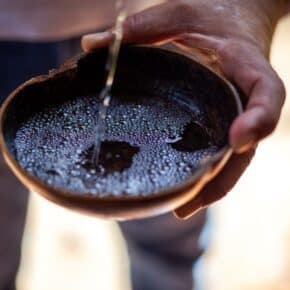What do we mean when we talk aout the classes of mezcal? While most people are familiar with the three high level categories of mezcal featured prominently on labels – mezcal ancestral, mezcal artesanal, and mezcal – there are other descriptors. We break down the various classes of mezcal below. We’ll answer questions such as: What is abocado? What’s the difference between reposado and madurado en vidrio? And how long must a mezcal be aged to be called a reposado?
The six classes of mezcal
Joven or Blanco
Directly translated it means “young” or “white.” This is used to describe mezcal that isn’t aged in wood, and does not have any additional ingredients or treatments. These mezcals are generally completely transparent in color and can represent one of the purest expressions of agave flavor.
Reposado
A reposado mezcal must be aged between 2-12 months in wood barrels. The color of the mezcal can be a soft yellow or amber. It can also pick up additional colors and flavors from the type of wood used in the barrels. American oak, especially used whiskey barrels, have been very popular. Generally, barrel aging mellows the base mezcal and adds flavors of vanilla and caramel. For more information on this class of mezcal, check our mezcal encylopedia entry on reposado mezcal.
Añejo
This is a mezcal that has been aged for at least 12 months in wood barrels of a maximum of 1,000 liters in size. Generally these mezcals are much darker than reposados, with rich mahogany colors. They also tend to taste much rounder, with intensified notes of vanilla and caramel but also of other spices like clove and cinnamon. For more information on this class of mezcal, check our mezcal encylopedia entry on añejo mezcal.
Madurado en Vidrio
Directly translated, this means “matured in glass.” This is a mezcal that has been put in glass containers right after production. Most commonly these are glass garafones which resemble the carboys that home beer makers use. Sometimes this is referred to as “rested” mezcal.
So what happens to the mezcal when it is maturing in glass? Joahna Hernandez looked at the science behind resting in glass and found that, “once the product is distilled, its different compounds are still changing since the molecules that control the organoleptic profile are dispersed. When putting the distillate to rest, these compounds calm down and start coming together, the fermentation creates flavors and aromas that become softer with maturation. When the spirit is poured into the glass container, a certain headspace is left which allows for an expansion of volatile compounds.”
Abocado con
Loosely translated, this means a mezcal that has been exposed or infused with other flavorings after distillation. The is a contrast to pechugas, which are distilled with ingredients. In the past mezcals that contained the gusano larva would have been classified as “Abocado con gusano” but there are many different traditional infusions of local ingredients like herbs, spices, nuts, grasses, fruits, and other vegetal matter. Occasionally abocados contain sugar, sugar cane, honey, worms, or scorpions.
NOM 70 specifically cites the following ingredients: “maguey larva, damiana, lemon, honey, orange, mango, among others.” It goes on to say that those other ingredients are approved “as long as they are approved by the Secretary of Health.” (Emphasis ours.) For more information on these classes of mezcal, check out our Mezcal Encylcopedia.
Destilado con
These are mezcals that are distilled with non-agave ingredients and are mostly known as pechugas in the market. In this process, flavorings like fruits, spices, herbs or meats are added to the second or third distillation to provide a different layer of flavor.













Leave a Comment